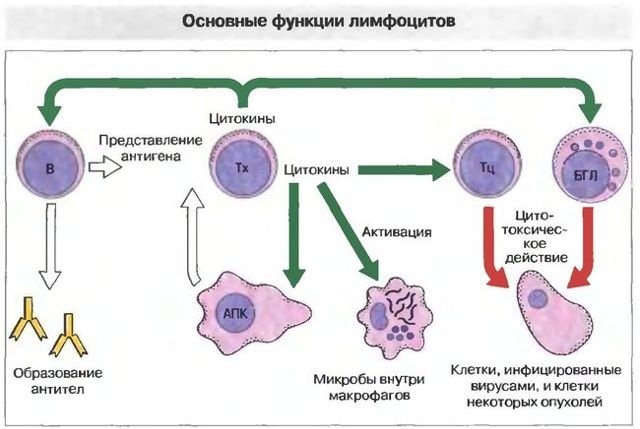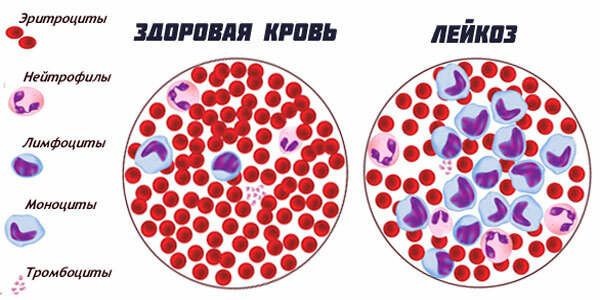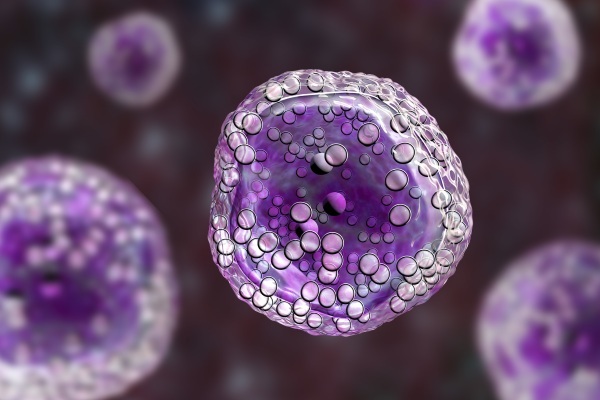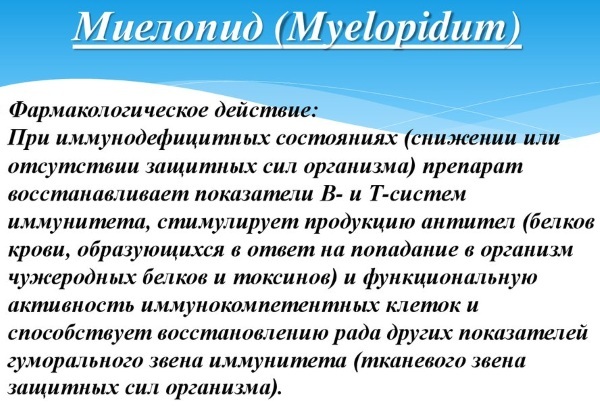Annual donation of venous blood for analysis will make it possible to diagnose the presence of a disease in the human body in a timely manner. Presence in blood in adults and children atypical lymphocytes indicates the onset of pathology and requires treatment.
Record content:
- 1 Functions in the body
- 2 How and under what conditions is it produced
- 3 Indicator table is normal
- 4 Symptoms of the rise and fall
- 5 Reasons for promotion and demotion
- 6 Indications for research
- 7 How is it determined
- 8 Preparation and analysis
- 9 Decoding the results
- 10 When to see a doctor
-
11 How to bounce back
- 11.1 Medications
- 11.2 Traditional methods
- 11.3 Other methods
- 12 Possible complications
- 13 Video about lymphocytes
Functions in the body
The protection of the body from the pathogenic microflora is performed by lymphocytes. They are responsible for humoral and cellular immunity. Lymphocytic elements create antibodies to destroy foreign cells. The cells of the immune system are produced by the bone marrow.
In the blood of an adult, lymphocytes make up 35% of all leukocytes, in children - 50%. Their number prevails over other blood cells, can reach 1500 per 1 μl.
By function, there are three types of lymphocytes:
- NK cells in the form of granules - destroy virus-infected and tumor cells;
- B cells - form special antibodies that kill dangerous cells;
-
T cells are composed of suppressor T cells, helper T cells, and killer T cells. T-killers - are responsible for normalizing the immune system, T-helpers - help to produce antibodies, and T-suppressors - inhibit this process.

Lymphocytes can change their shape, which differs from the established norm, as a result of exposure pathogenic microflora or a negative reaction associated with the manifestation of an allergy to medicinal drugs. The altered lymphocytes are called atypical.
How and under what conditions is it produced
Atypical lymphocytes in a blood test in adults and children appear due to the struggle of the immune system with a possible disease.
As a result, normal lymphocytes can change their morphological structure, turn into reactive and change its parameters:
- in appearance - unlike their normal round, they become polygonal, having ragged contours;
- in size - normal - 12 microns, modified - increased;
- along the core - in the normal state - round; the rebuilt core is elongated, elongated and has elongated cracks;
- by color - the color of the wrong lymphocyte is much brighter when combined with the reagent during the analysis;

In the analysis of the blood of adults and children, the presence of atypical lymphocytes occurs due to an increase in the number of normal lymphoid cells. The reason is an infection or an allergen in the human body.
An increase in the number of lymphoid elements in medicine is called lymphocytosis, which is distinguished in three types: reactive and post-infectious (the result of an infectious lesion and weakening of the body), malignant (informs about the development of oncological diseases).
Indicator table is normal
Atypical lymphocytes in a blood test in adults and children are absent in a healthy and strong body. A deviation from the norm can signal the occurrence of lymphocytosis or lymphopenia. The permissible content of reactive cells is 6%, the value above requires treatment.
The table shows the norms for the content of lymphocytes as a percentage of the total the number of leukocytes for children and adults of different sex and age:
| The patients | Adults | Children | |||
| 15 to 19 years old | Over 19 years old | Up to a year | 1 to 5 | 5 to 9 | 9 to 15 |
| Lymphocytes in% | |||||
| Men | 30-45 | 19-37 | |||
| Women | 30-45 | 19-37 | |||
| Children | 45-70 | 33-50 | 30-50 | 30-45 |
Symptoms of the rise and fall
It is almost impossible to recognize the presence of lymphocytosis. An increase in lymphocytes is an indicator of the presence of pathology in the body.
Symptoms depend on the underlying disease:
- enlarged lymph nodes;
- decrease or increase in body temperature;
- deterioration of health;
- migraine;
- loss of appetite with vomiting, chills, and diarrhea.

Deviation from the norm in terms of the lymphocyte count towards a decrease (lymphocytopenia or lymphopenia), also does not have pronounced symptoms.
There are several indirect signs by which it is possible to establish the onset of the development of the disease:
- general fatigue;
- decreased performance;
- deterioration of health;
- in women, hypoplasia of the tonsils of the lymphopharyngeal ring may be observed.
Reasons for promotion and demotion
Atypical lymphocytes in a blood test in adults and children appear as a result of lymphocytosis.
Reasons for the formation of reactive lymphocytes:
- infection with any infectious disease, from sore throat to measles;
- brucellosis - infection from a sick animal;
- toxoplasmosis acquired through infection from a sick domestic or wild animal and affecting the human immune system;
- lymphocytic leukemia - a malignant lesion of the lymph nodes due to the accumulation of cancer cells in them;

- whooping cough - a dangerous viral infection of the respiratory tract in children;
- serum sickness caused by an allergic reaction to certain proteins of animal and plant origin that have entered the body with food or drugs;
- venereal diseases at an early stage;
- during the recovery process after suffering severe infectious lesions of the body.
Lymphopenia can be hereditary or acquired. Hereditary - associated with genetic changes leading to a decrease in the number of lymphocytes and a deterioration in their quality. Acquired - depletes white blood cells, and is not related to heredity.
Lymphocytopenia has 2 types: relative (the number of lymphocytes decreases directly in the leukocyte formula) and absolute (a decrease in the total number of the main cells of the immune system).
Causes of low blood lymphocytes:
- anemia, a decrease in erythrocytes and blood hemoglobin;
- leukemia, cancer of the hematopoietic system;
- the consequence of chemical therapy;
- radiation sickness;
- hereditary immunodeficiency;
- HIV.
Indications for research
The donation of venous and capillary blood shows the changes that occur in the body.
The study of the level of lymphocytes in adults is carried out as a result of:
- transferred infectious disease, long-term;
- a tendency to have severe drug allergies or infections;
- manifested symptoms of insufficient body resistance;
- available data on the formation of tumors of different localization;
- suffered heavy surgical interventions;
- the upcoming preparation for the operation;
- long period of medication;
- pregnancy (especially important, since during this period immune reactions occur in the body of women).
Indications for research in children:
- preventive examination - once a year;
- examination of chronically ill children - several times a year, depending on the diagnosis;
- prolonged treatment of a simple disease;
- health complaints without specific symptoms;
- complications of childhood diseases;
- the effectiveness of medicines in the treatment of a child.
A doctor-hematologist conducts an examination according to the results of ready-made tests, which serve as the basis for further treatment.
How is it determined
To determine the number of lymphocytes in the blood, manual (there is a possibility of a doctor's and laboratory assistant's error) and semi-automatic (inaccuracy excluded) methods are used.
The manual method includes:
- with the help of Goryaev's camera;
- counting cells under a microscope;

- counting in a biopsy.
To establish the qualitative and quantitative composition of lymphocytes, a general blood test is done.
Preparation and analysis
For an objective assessment of the blood test, it is important to follow the established rules on the eve of the test:
- dinner should be light;
- do not drink alcohol;
- exclude tobacco smoking;
- do not take strong medications;
- avoid stressful situations;
- a full 8-hour sleep is required;
- postpone breakfast on the day of donation.
There are two ways to obtain biomaterial (blood) for analysis. The first involves sampling blood from a finger by puncturing the ring, middle or index fingers with a disposable needle. The little finger and thumb are not pierced, this is prohibited due to the danger of infection through punctures in these places.
The blood supply in the hand area is reduced, and if the patient's skin is thick, then a special device is used, the puncture is carried out automatically. This procedure is less painful, it is used when taking blood from children.
The second method involves obtaining blood from a vein. The hand in the area of the forearm is pulled with a tourniquet. The patient, by squeezing and unclenching the hand, increases the blood flow, in which it is easier for the nurse to see the veins on the inner side of the bend of the elbow joint. By piercing the vein with a disposable syringe, a small amount of blood is drawn for analysis.
The analysis results are ready within 24 hours, in case of emergency - earlier.
Decoding the results
The test results are entered into a form and sent to the patient by e-mail or printed on a special form and handed out.
The content of lymphocytes in the blood is displayed as a percentage of leukocytes, the "%" icon is used. In the table above, the norms for the content of lymphocytes for children and adults are indicated, depending on age and gender. If you want, you can find out the number of lymphocytes yourself: the norm of lymphocytes is 20-40% of the total number of all leukocytes.
Leukocytes are indicated in absolute numbers per liter of blood, Nx10 9, (the number 10 to the 9th degree) and are marked with the abbreviation LYM. This number should be multiplied by a percentage.
When to see a doctor
The immune system reacts sharply to any danger to the body. Lymphocytes can increase from a mild cold, hypothermia or overheating, from drinking alcohol or tobacco, from stressful situations and overwork. In women, lymphocytes increase during menstruation and during pregnancy.
You cannot self-medicate. Even lymphocytosis is not a disease, but a signal that the immune system is prepared to resist a possible disease. And if the deviation in the number of lymphocytes exceeds 10-15% of the norm, you should contact your doctor for advice and the appointment of an additional examination.
Atypical lymphocytes in a blood test in adults and children can only be detected in a specialized clinic with a detailed study. The presence of reactive lymphocytes indicates disease.
The hematologist will determine the cause of the increased or decreased lymphocyte count, establish the fact of the appearance of atypical white blood cells. Further treatment will depend on the diagnosis made by the doctor, he will also tell you who the specialist should contact.
How to bounce back
It is possible to lower the indicators after identifying and eliminating the causes of the increase in lymphocytes.
If the deviation from the norm is not associated with the disease, then to restore the balance of cells, it is enough to use more liquid, use foods rich in amino acids and trace elements, especially zinc and vitamin C.

Emotional and physical stress leads to an imbalance of the immune system. Improper nutrition, bad habits, stressful situations adversely affect the protective functions of the body.
With acquired lymphopenia, etiotropic therapy of the underlying disease is carried out, which is the root cause of its development.
In cases where the number of lymphocytes exceeded the norm by 15% or fell to the unacceptable 15%, you should:
- observe hygiene;
- do not visit crowded places;
- do not contact sick people;
- do not touch animals;
- avoid cuts and scrapes on the skin;
- see a doctor.
Medications
The use of drugs to normalize the work of protective cells is called immunotherapy.
There are several groups of similar means of different actions:
- Thymic immunomodulators - thymalin, thymostimulin, thymogen. These drugs are designed to increase the number and activation of T lymphocytes.
-
Bone marrow immunomodulators - myelopid and seramil. The object of their influence is B-lymphocytes. They increase general and cellular immunity.

- Cytokines - a combined group of interferons and interleukins. These include viferon, roferon-A, altevir, pegasis, betaerone, imukin, betaleukin, which are a colony-stimulating factor for the body.
- Immunostimulants - bronchmunal, ribomunil purposefully work with cells occupied by phagocytosis. The result of their action is an increase in the number of lymphocytes and their activation.
- Synthetic immunomodulators - nucleic acids that stimulate the formation of phagocytes.
These drugs normalize the number of lymphocytes and increase their activity, help to remove the body's circulating immune complexes, thereby unloading the work of lymphocytes, increasing their protective activity.
Traditional methods
It is worth resorting to folk methods of normalizing the content of lymphocytes in the blood only if the cause is established, the disease that caused it is known.
If the identified lymphocytosis is caused by a viral infection, use:
- Linden flower infusion:
- pour 1/2 liter of boiling water 3 tbsp. dry linden flowers;
- insist 0.5 hours;
- take 100 ml during the day.
In 2 weeks, the disease will pass, and the lymphocyte count will return to normal.
- Propolis tincture:
- 300g. propolis is insisted for a month in 700 g of alcohol;
- take 2 tbsp. 3 times a day for a month.
- Barley decoction:
- Boil 1.5 cups of barley in 2 cups of water until the liquid is halved;
- you need to drink the broth in the morning on an empty stomach, half a glass for a month.
To stop the growth of lymphocytes, beet infusion is used:
- cut the root vegetable into cubes and pour 1.5 liters of hot water;
- add 1 tsp. salt and honey;

- use a glass 3 times a day for 2 weeks.
They will help white blood cells to recover to normal: an active lifestyle, jogging in the morning, visiting a fitness club, avoiding overwork and stress. Introduce steamed buckwheat and chicory drink into the diet.
Other methods
The most dangerous for human health and life is the loss of protective functions of the body as a result of AIDS and the development of malignant neoplasms.
A general decrease in all types of white blood cells leads to immunosuppression, decreased immunity and increased risk defeat by viruses, fungi, bacteria and other dangerous microflora, also after chemotherapy.
Doctors recommend choosing special foods that increase the level of leukocytes in the blood. This method has been confirmed and clinically tested, it gives a positive immunostimulating effect.
The diet should contain foods containing:
- Tocopherol (vitamin E) - found in the seeds of oil plants. Stimulates the activity of NK cells, cytotoxic to malignant neoplasms and cells affected by pathogenic microflora. Promotes the production of B-lymphocytes, which are responsible for the generation of antibodies.
- Zinc - provides an increase in the number of T-killers and activates B-lymphocytes. The main source is beef meat, poultry eggs and seafood.
-
Selenium - has an immunostimulating effect. Contained in legumes.

- Green tea antioxidants - stimulate lymphocytopoiesis.
- Ascorbic acid (vitamin C) - affects the formation of leukocytes, the generation of interferons. There is a lot of it in black currant, citrus fruits.
- Beta carotene - stimulates the reproduction of T-lymphocytes. Prevents free radical saturation of lipids. The source of beta-carotene is carrots.
- Retinol(vitamin A) - ensures the reproduction of erythrocytes, phagocytes and platelets. Apricots, pumpkins and carrots are rich in provitamin, which is synthesized in the body into retinol.
- Omega-3 fatty acids - the strongest immunostimulant. Found in vegetable fats and seafood.
Possible complications
Failure to take measures to strengthen the immune system is fraught with further progress of the existing disease. If the level of lymphocytes continues to decline, the immune system will begin to weaken, antibodies will not be able to resist pathogenic microflora, which will begin to multiply actively in a favorable bloodstream environment, will cause sepsis and lethal Exodus.
A progressive disease with an affected immune system contributes to the manifestation of dangerous complications. This is the degeneration of benign tumors into malignant ones, the transition of the disease from the acute phase to the chronic one, the threat of miscarriage in pregnant women.
It is important to remember that the annual donation of blood for analysis to adults and children will allow timely identification of possible deviations in its composition. The detection of more than 6% of atypical lymphocytes in the final studies in patients is a signal of the presence of a disease and an active resistance of the immune system.
Article design: Vladimir the Great
Video about lymphocytes
Malysheva on lymphoma:



